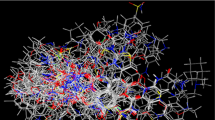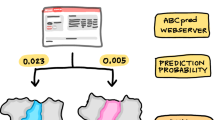Abstract
Alzheimer’s disease (AD) accounts for almost three quarters of dementia patients and interferes people’s normal life. Great progress has been made recently in the study of Acetylcholinesterase (AChE), known as one of AD’s biomarkers. In this study, acetylcholinesterase inhibitors (AChEI) were collected to build a two-dimensional structure–activity relationship (2D-SAR) model and three-dimensional quantitative structure–activity relationship (3D-QSAR) model based on feature selection method combined with random forest. After calculation, the prediction accuracy of the 2D-SAR model was 89.63% by using the tenfold cross-validation test and 87.27% for the independent test set. Three cutting ways were employed to build 3D-QSAR models. A model with the highest \({q}^{2}\) (cross-validated correlation coefficient) and \({r}^{2 }\)(non-cross-validated correlation coefficient) was obtained to predict AChEI activity. The mean absolute error (MAE) of the training set and the test set was 0.0689 and 0.5273, respectively. In addition, molecular docking was also employed to reveal that the ionization state of the compounds had an impact upon their interaction with AChE. Molecular docking results indicate that Ser124 might be one of the active site residues.










Similar content being viewed by others
References
Long CO, Dougherty J (2003) What’s new in Alzheimer’s disease? Home Healthc Nurse 21:14
Karolien B, Kristel S, Christine VB (2010) Current status on Alzheimer disease molecular genetics: from past, to present, to future. Hum Mol Genet R1:R4–R11. doi:10.1093/hmg/ddq142
Harris ME, Hensley K, Butterfield DA, Leedle RA, Carney JM (1995) Direct evidence of oxidative injury produced by the Alzheimer’s beta-amyloid peptide (1–40) in cultured hippocampal neurons. Exp Neurol 131:193–202
Dodart JC, Marr RA, Koistinaho M, Gregersen BM, Malkani S, Verma IM, Paul SM (2005) Gene delivery of human apolipoprotein E alters brain A \({\upbeta }\) burden in a mouse model of Alzheimer’s disease. PNAS 102:1211–1216. doi:10.1073/pnas.0409072102
Lewczuk P, Esselmann H, Bibl M, Beck G, Maler Juan M, Otto M, Kornhuber J, Wiltfang J (2004) Tau protein phosphorylated at threonine 181 in CSF as a neurochemical biomarker in Alzheimer’s disease. J Mol Neurosci 23:115–122. doi:10.1385/JMN:23:1-2:115
Hardy J, Selkoe DJ (2002) The amyloid hypothesis of Alzheimer’s disease: progress and problems on the road to therapeutics. Science 297:353–356. doi:10.1126/science.1072994
Bartus RT, Dean RL, Beer B, Lippa AS (1982) The cholinergic hypothesis of geriatric memory dysfunction. Science 217:408–414. doi:10.1126/science.7046051
Dineley KT, Pandya AA, Yakel JL (2015) Nicotinic ACh receptors as therapeutic targets in CNS disorders. Trends Pharmacol Sci 36:96–108. doi:10.1016/j.tips.2014.12.002
Farlow M, Gracon SI, Hershey LA (1993) Tacrine for treatment of Alzheimer’s disease. Physician Assist 17:112
Sparano N (1998) Donepezil for Alzheimer’s disease. J Fam Pract 46:356
Nordberg PA, Svensson A-L (1998) Cholinesterase inhibitors in the treatment of Alzheimer’s disease. Drug Saf 19:465–480. doi:10.2165/00002018-199819060-00004
Lee S, Barron MG (2015) Development of 3D-QSAR model for acetylcholinesterase inhibitors using a combination of fingerprint, molecular docking, and structure-based pharmacophore approaches. Toxicol Sci 148:60–70. doi:10.1093/toxsci/kfv160
Ambure P, Kar S, Roy K (2014) Pharmacophore mapping-based virtual screening follow by molecular docking studies in search of potential acetylcholinesterase inhibitors as anti-Alzheimer’s agents. Biosystems 116:10–20. doi:10.1016/j.biosystems.2013.12.002
Pereira F, Latino DA, Gaudêncio SP (2015) QSAR-assisted virtual screening of lead-like molecules from marine and microbial natural sources for antitumor and antibiotic drug discovery. Molecules 20:4848–4873. doi:10.3390/molecules20034848
Chen HF, Dong XC, Zen BS, Gao K, Yuan SG, Panaye A, Doucet JP, Fan BT (2003) Virtual screening and rational drug design method using structure generation system based on 3D-QSAR and docking. SAR QSAR Environ Res 14:241–264. doi:10.1080/1062936032000101493
Bruno JN, Rafael FD, Mario RS, Cleber CM, Walter CGV, Ana CMA, João MR, Elid FCL, Ross P, Nicholas F, Eugene M, Lee K, Anne EC, Rodolpho CB, Floriano PS, Carolina HA (2016) Discovery of new anti-schistosomal hits by integration of QSAR-based virtual screening and high content screening. J Med Chem 59:7075–7088. doi:10.1021/acs.jmedchem.5b02038
Dash M, Liu H (2003) Consistency-based search in feature selection. Artif Intell 151:155–176. doi:10.1016/S0004-3702(03)00079-1
Bing N, Yuchao Z, Juan D, Yin L, Miao W, Wencong L, Xiaochen Y, Jinyuan Y (2014) Predicting network of drug-enzyme interaction based on machine learning method. BBA Proteins Proteom 1844:214–223. doi:10.1016/j.bbapap.2013.07.008
Sancetta A (2016) Greedy algorithms for prediction. Bernoulli 22:1227–1277. doi:10.3150/14-BEJ691
Hou C, Jiao L (2010) Selecting features of linear-chain conditional random fields via greedy stage-wise algorithms. Pattern Recognit Lett 31:151–162. doi:10.1016/j.patrec.2009.09.025
Liu Y, Tang F, Zeng Z (2015) Feature selection based on dependency margin. IEEE Trans Cybern 45:1209–1221. doi:10.1109/TCYB.2014.2347372
Zielosko B, Piliszczuk M (2008) Greedy algorithm for attribute reduction. Fund Inform 45:549–561. doi:10.1109/TCYB.2014.2347372
Pearson WR (2000) Flexible sequence similarity searching with the FASTA 3 program package. Methods Mol Biol 132:185–219
Akhoondzadeh M (2016) Decision tree, bagging and random forest methods detect TEC seismo-ionospheric anomalies around the time of the Chile, (\(M_w=8.8\)) earthquake of 27 February 2010. Adv Space Res 57:2464–2469. doi:10.1016/j.asr.2016.03.035
Cramer RD (2003) Topomer CoMFA: a design methodology for rapid lead optimization. J Med Chem 46:374–388. doi:10.1021/jm020194o
Piazzi L, Belluti F, Bisi A, Gobbi S, Rizzo S, Bartolini M, Andrisano V, Recanatini M, Rampa A (2007) Cholinesterase inhibitors: SAR and enzyme inhibitory activity of 3-[omega-(benzylmethylamino)alkoxy]xanthen-9-ones. Bioorg Med Chem 15:575–585. doi:10.1016/j.bmc.2006.09.026
Rosini M, Andrisano V, Bartolini M, Bolognesi ML, HreliaP Minarini A, Tarozzi A, Melchiorre C (2005) Rational approach to discover multipotent anti-Alzheimer drugs. J Med Chem 48:360–363. doi:10.1021/jm049112h
Recanatini M, Cavalli A, Belluti F, Piazzi L, Rampa A, Bisi A, Gobbi S, Valenti P, Andrisano V, Bartolini M, Cavrini V (2000) SAR of 9-amino-1,2,3,4-tetrahydroacridine-based acetylcholinesterase inhibitors: synthesis, enzyme inhibitory activity, QSAR, and structure-based CoMFA of tacrine analogues. J Med Chem 43:2007–2018. doi:10.1021/jm990971t
Rampa A, Piazzi L, Belluti F, Gobbi S, Bisi A, BartoliniM Andrisano V, Cavrini V, Cavalli A, Recanatini M, Valenti P (2001) Acetylcholinesterase inhibitors: SAR and kinetic studies onomega-[N-Methyl-N-(3-alkylcarbamoyloxyphenyl)methyl]aminoalkoxyaryl Derivatives. J Med Chem 44:3810–3820. doi:10.1021/jm010914b
Elsinghorst P, Tanarro C, Gutschow M (2006) Novel heterobivalent tacrine derivatives as cholinesterase inhibitors with notable selectivity toward butyrylcholinesterase. J Med Chem 49:7540–7544. doi:10.1021/jm060742o
Elsinghorst PW, Cieslik JS, Mohr K, Tränkle C, Gütschow M (2007) First gallamine-gacrinehybrid: design and characterization at cholinesterases and the M2 muscarinic receptor. J Med Chem 23:5685–5695. doi:10.1021/jm070859s
Camps P, Formosa X, Galdeano C, Gómez T, Muoz-Torrero D, Scarpellini M, Viayna E, Badia A, Clos MV, Camins A, Pallas M, Bartolini M, Mancini F, Andrisano V, Estelrich J, Lizondo M, Bidon-Chanal A, Luque FJ (2008) Novel donepezil-based inhibitors of acetyl and butyrylcholinesterase and acetylcholinesterase-induced \({\varvec {\upbeta }}\)-amyloid aggregation. J Med Chem 51:3588–3598. doi:10.1021/jm8001313
Csizmadia F (2000) JChem: Java applets and modules supporting chemical database handling from web browsers. J Chem Inf Comp Sci 40:323–324. doi:10.1021/ci9902696
Sudhir V, Richard S (2006) Bias in error estimation when using cross-validation for model selection. BMC Bioinform 7:91–98. doi:10.1186/1471-2105-7-91
Wang L, Shen H, Li B, Hu D (2011) Classification of schizophrenic patients and healthy controls using multiple spatially independent components of structural MRI data. Front Electr Electron Eng China 6:353–362. doi:10.1007/s11460-011-0142-2
Zhang YP, Sussman N, Herbert S, Rosenkranz Klopman G (1997) Development of methods to ascertain the predictivity and consistency of SAR models: application to the U.S. national toxicology program rodent carcinogenicity bioassays. Quant Struct Act Relationsh 16:290–295. doi:10.1002/qsar.19970160403
Roy K, Das RN, Ambure P, Aher RB (2016) Be aware of error measures. Further studies on validation of predictive QSAR models. Chemometr Intell Lab 152:18–33. doi:10.1016/j.chemolab.2016.01.008
Shuling Y, Jintao Y, Jiahua S, Xiaojiao R, Ting Z, Yanli W, Yu D (2015) HQSAR and topomer CoMFA for predicting melanocortin-4 receptor binding affinities of trans-4-(4-chlorophenyl) pyrrolidine-3-carboxamides. Chemometr Intell Lab 146:34–41. doi:10.1016/j.chemolab.2015.04.017
Jilek R, Cramer R (2004) Topomers: a validated protocol for their self-consistent generation. J Chem Inf Comput Sci 44:1221–1227. doi:10.1021/ci049961d
Kumar S, Tiwari M (2015) Topomer-CoMFA-based predictive modelling on 2, 3-diarylsubstituted-1, 3-thiazolidin-4-ones as non-nucleoside reverse transcriptase inhibitors. Med Chem Res 24:245–257. doi:10.1007/s00044-014-1105-y
Bartolucci C, Perola E, Pilger C, Fels G, Lamba D (2001) Three-dimensional structure of a complex of galanthamine (Nivalin) with acetylcholinesterase from Torpedo Californica: Implications for the design of new anti-Alzheimer drugs. Proteins 42:182–191. doi:10.1002/1097-0134(20010201)42:2<182::AIDPROT50>3.0.CO;2-1
Ghose AK, Jaeger EP, Kowalczyk PJ, Peterson ML, Treasurywala AM (1993) Conformational searching methods for small molecules. I. Study of the sybyl search method. J Comput Chem 14:1050–1065. doi:10.1002/jcc.540140907
Smith DA, Beaumont K, Maurer TS, Di L (2015) Volume of distribution in drug design. J Med Chem 58:5691–5698. doi:10.1021/acs.jmedchem.5b00201
Ji WJ, Chung BH, Eung KK, Seo KY, Kim T (2015) The effects of Two non-steroidal anti-inflammatory drugs, bromfenac 0.1% and ketorolac 0.45%, on cataract surgery. Yonsei Med J 56:1671–1677. doi:10.3349/ymj.2015.56.6.1671
Pieńko T, Grudzien M, Taciak PP, Mazurek AP (2016) Cytisine basicity, solvation, log P, and log D theoretical determination as tool for bioavailability prediction. J Mol Graph Model 63:15–21. doi:10.1016/j.jmgm.2015.11.003
Xiang Y, Song J, Zhang Z (2014) Topomer CoMFA and virtual screening studies of azaindole class renin inhibitors. Comb Chem High Throughput Screen 17:458–472. doi:10.2174/1386207317666140107094708
Kumar S, Tiwari M (2015) Topomer-CoMFA-based predictive modelling on 2,3-diaryl-substituted-1,3-thiazolidin-4-ones as non-nucleoside reverse transcriptase inhibitors. Med Chem Res 24:245–257. doi:10.1007/s00044-014-1105-y
Nilewar SS, Kathiravan MK (2014) 3D CoMFA, CoMSIA, topomer CoMFA and HQSAR studies on aromatic acid esters for carbonic anhydrase inhibitory activity. J Chemom 28:60–70. doi:10.1002/cem.2574
Yuanxin T, Yudong S, Xianzuo Z, Lianbao Y, Zhonghuang L, Zhong L, Jiajie Z, Shuguang W (2014) Design some new type-I c-met inhibitors based on molecular docking and topomer CoMFA research. Mol Inf 33:536–543. doi:10.1002/minf.201300118
Tresadern G, Cid JM, Trabanco AA (2014) QSAR design of triazolopyridine mGlu2 receptor positive allosteric modulators. J Mol Graph Model 53:82–91. doi:10.1016/j.jmgm.2014.07.006
Sussman JL, Harel M, Frolow F, Oefner C, Goldman A, TokerL Silman I (1991) Atomic structure of acetylcholinesterase from Torpedo californica: a prototypic acetylcholine-binding protein. Science 253:872–879. doi:10.1126/science.1678899
Ordentlich A, Barak D, Kronman C, Flashner Y, Leitner M, Segall Y, Ariel N, Cohen S, Velan B, Shafferman A (1993) Dissection of the human acetylcholinesterase active center determinants of substrate specificity. Identification of residues constituting the anionic site, the hydrophobic site, and the acyl pocket. J Biol Chem 268:17083–17095
Yves B, Taylor P, Radic Z, Pascale M (2003) Structural insights into ligand interactions at the acetylcholinesterase peripheral anionic site. EMBO J 22:1–12. doi:10.1093/emboj/cdg005
Gibney G, Camp S, Dionne M, Mac QK, Taylor P (1990) Mutagenesis of essential functional residues in acetylcholinesterase. PANS 87:7546–7550
Harel M, Schalk I, Ehret-Sabatier L, Bouet F, Goeldner M, HirthC Axelsen PH, Silman I, Sussman JL (1993) Quaternary ligand binding to aromatic residues in the active-site gorge of acetylcholinesterase. Proc Natl Acad Sci 90:9031–9035
Shafferman A, Barak D, Kaplan D, Ordentlich A, Kronman C, Velan B (2005) Functional requirements for the optimal catalytic configuration of the AChE active center. Chem Biol Interact 157–158:123–131. doi:10.1016/j.cbi.2005.10.021
Carlacci L, Millard CB, Olson MA (2004) Conformational energy landscape of the acyl pocket loop in acetylcholinesterase: a Monte Carlo-generalized Born model study. Biophys Chem 111:143–157. doi:10.1016/j.bpc.2004.05.007
Ordentlich A, Barak D, Kronman C, Ariel N, Segall Y, VelanB Shafferman A (1998) Functional characteristics of the oxyanion hole in human acetylcholinesterase. J Biol Chem 273:19509–19517. doi:10.1074/jbc.273.31.19509
Acknowledgements
The author would like to thank scholarship from Shanghai Municipal Education Commission, the National Natural Science Foundation of China (81271384, 81371623, 31571171 and 31100838, Shanghai Key Laboratory of Bio-energy Crops (13DZ2272100), the Shanghai Natural Science Foundation (Grant No. 15ZR1414900), the Key Laboratory of Medical Electrophysiology (Southwest Medical University) of Ministry of Education of China (Grant No. 201502), and the Young Teachers of Shanghai Universities Training Program. We also would like to thank Mingyue Zheng Professor from the State Key Laboratory of Drug Research of Chinese Academy of Sciences for helping compute the ionization of the compounds at physiological pH 7.4.
Author information
Authors and Affiliations
Corresponding authors
Additional information
Bing Niu and Manman Zhao have contributed equally to this work.
Electronic supplementary material
Below is the link to the electronic supplementary material.
Rights and permissions
About this article
Cite this article
Niu, B., Zhao, M., Su, Q. et al. 2D-SAR and 3D-QSAR analyses for acetylcholinesterase inhibitors. Mol Divers 21, 413–426 (2017). https://doi.org/10.1007/s11030-017-9732-0
Received:
Accepted:
Published:
Issue Date:
DOI: https://doi.org/10.1007/s11030-017-9732-0




